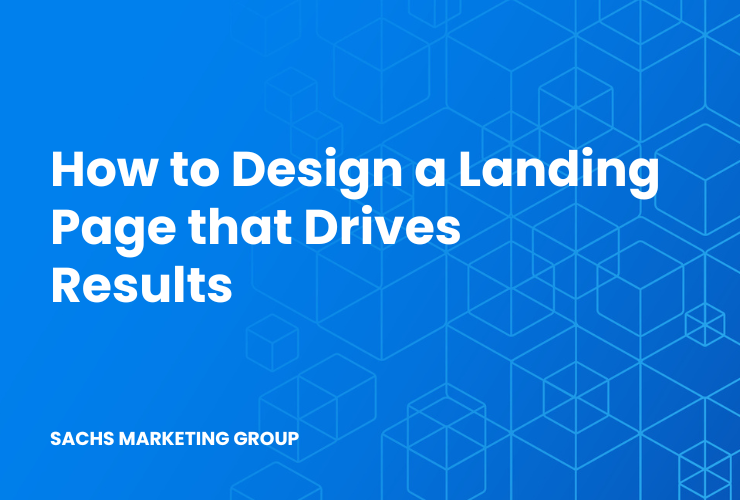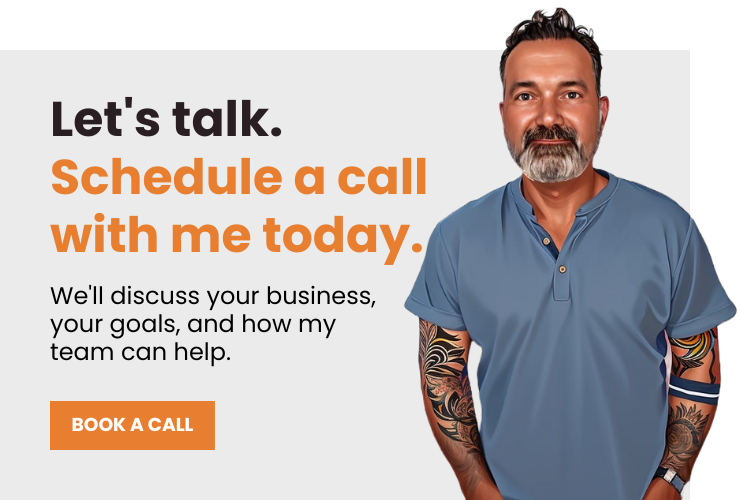Crafting a landing page that drives results is all about clarity and focus. Your landing page should immediately capture attention, communicate the value of your offer, and persuade visitors to take action. This involves compelling design, persuasive copy, and a deep understanding of your audience’s needs and pain points.
Struggling with landing pages can be a significant setback, leading to frustration and doubts about your digital marketing efforts.
This common challenge often stems from a need to understand what engages and converts visitors and how web design can help.
In this article, we’re exploring how to design a landing page and sharing a few tips to help you get started.

Overview
What is a Landing Page?
A landing page is a standalone web page, distinct from your main website, designed for a specific purpose. It’s where a visitor ‘lands’ after clicking on a link in an email or ads from Google, YouTube, Facebook, or similar places on the web.
Web design plays an important role in your overall digital marketing
Its primary goal is to convert visitors into leads or customers.
How to Design a Landing Page that Drives Results
Designing a landing page that drives results is about creating a focused, engaging user experience tailored to specific goals.
It’s not just about visual appeal – it’s about constructing a journey for your visitor that is both intuitive and compelling. Each element, from the headline to the call-to-action (CTA), plays a strategic role, aiming to captivate and guide visitors toward a specific action. We’ve discussed the importance of web design before, and landing pages are a great example of how much of an impact website design can have on your business.
Here’s how to design a landing page that drives results:
Start with a Benefit-focused Headline
Your headline is the first impression users have of your landing page, so it must be compelling.
A benefit-focused headline addresses your audience’s needs or problems and offers a solution. It should be clear and concise and speak directly to the main advantage your product or service provides.
This approach helps to instantly engage the visitor by highlighting what they stand to gain, setting the stage for the rest of your landing page content.
For example, a company in the addiction rehab industry might use “Transform Your Life: Begin Your Journey to Recovery Today” as a benefit-focused headline.
Use an Image Illustrating the Offer
The right image can speak volumes, conveying the essence of your offer more effectively than words alone.
Choose an image that illustrates the benefits or uses of your product or service. It should resonate with your target audience, creating an emotional connection and reinforcing the message of your headline.
High-quality, relevant images help make your offer tangible and relatable, thus enhancing the overall appeal of your landing page and aiding in the conversion process.
Add a Lead Form Above the Fold
Placing a lead form above the fold ensures it’s one of the first things visitors see without scrolling.
This strategic placement can significantly increase the likelihood of conversion. The form should be simple and not ask for too much information, which can deter potential leads.
Make it easy for visitors to provide their details, and consider using engaging language or offering incentives to encourage form completion.
Include a Clear Call-to-Action Prominently
A clear and prominent call-to-action (CTA) guides visitors toward your conversion goal.
It should stand out visually and be placed strategically on your landing page, ideally near the headline or at the end of persuasive content.
The CTA language must be action-oriented, creating a sense of urgency or benefit. Ensure it aligns with the overall goal of your landing page, whether it’s to subscribe, download, buy, or learn more.
For example, mental health professionals might use “Get Help Now – Schedule Your Free Consultation Today” as a CTA throughout their landing pages and digital marketing campaigns.
Check this out: The Ultimate Guide to Mental Health Website Design
Use Compelling Copy
Crafting compelling copy is essential in engaging and persuading your visitors.
Your words should resonate with your audience’s needs, aspirations, and pain points, creating a narrative that leads them toward taking action. The copy should be clear, persuasive, and benefits-focused, emphasizing how your offer solves their problem or improves their life.
Avoid jargon and keep the language accessible and relatable, ensuring that every sentence adds value and guides the visitor closer to your call to action.
Related: 7 Copywriting Formulas and their Powerful Benefits
Provide Answers to Common Questions
Anticipating and addressing common questions in your landing page can significantly enhance user trust and confidence.
This involves identifying potential doubts or concerns your visitors might have and providing clear, concise answers.
Whether it’s about the product features, pricing, or the process involved, answering these questions upfront can eliminate barriers to conversion, making the decision-making process easier for your potential customers.
For example, doctors and physicians can include frequently asked questions like “What insurance do you accept?”
Remove All Navigation
Removing extraneous navigation from your landing page helps to keep your visitors focused on the specific action you want them to take.
You reduce the chances of distraction or decision fatigue by eliminating links that lead away from your page.
This streamlined approach ensures that your visitor’s attention remains solely on your offer and the call-to-action, increasing the likelihood of conversion.
Be Responsive to All Devices
In today’s digital landscape, mobile responsiveness is non-negotiable for landing pages.
A significant portion of web traffic comes from mobile devices, and a landing page that renders poorly on these platforms can lead to a high bounce rate and lost conversions.
Mobile-responsive design ensures that your page adjusts seamlessly to different screen sizes and resolutions, providing an optimal viewing experience for all users. This includes readable text without zooming, adequate space for tap targets, and fast loading times on mobile networks.
Prioritizing mobile responsiveness improves user experience and positively impacts search engine rankings.
Display Social Proof Prominently
Social proof on your landing page can significantly boost credibility and persuasive power.
This might include testimonials from satisfied customers, case studies, user reviews, or endorsements from well-known figures in the industry. These elements provide potential customers with tangible evidence of the value and effectiveness of your product or service. Social proof addresses the natural skepticism of online consumers by demonstrating that others have had positive experiences.
It’s a powerful tool that can tip the scales in favor of conversion, as people often rely on the opinions and experiences of others when making their own decisions.
Optimize for Speed
The loading speed of your landing page is critical for keeping visitors engaged.
In an era of short attention spans, a delay of even a few seconds can lead to increased bounce rates, as visitors will likely lose patience and leave.
Fast-loading pages provide a smoother user experience, encouraging visitors to stay and interact with your content. Optimizing images, minimizing code, and leveraging browser caching are some of the techniques that can improve loading speed.
Additionally, faster pages are favored by search engines, which can enhance your page’s visibility and drive more traffic.
Run A/B Tests for Insights
A/B testing, or split-testing, involves comparing two versions of your landing page to see which one performs better.
You can gain valuable insights into what resonates most with your audience by altering one element at a time – such as the headline, image, or call-to-action.
This method allows you to refine your landing page based on user responses, ensuring your design and content are optimized for maximum conversion.
Measure Results & Adapt
Measuring the performance of your landing page is crucial for understanding its effectiveness.
Utilize analytics tools to track metrics like conversion rates, bounce rates, and user behavior. This data will help you identify what’s working and what’s not, allowing for informed adjustments and improvements.
For example, medical practices might find that landing pages with a particular service, like telehealth consultations, result in more phone calls. In turn, the medical practice might use this insight to refresh its telehealth website design and incorporate more telehealth into its digital marketing campaigns.
Regularly updating your landing page based on these insights ensures that your strategies remain effective and responsive to your audience’s evolving needs and preferences.
You might be interested in this: 7 Google Analytics 4 (GA4) Metrics You Should Track
Hire a Professional Designer
Hiring a professional web designer for your landing page can be a game-changer.
Expert designers bring a blend of aesthetic sensibility and technical know-how, ensuring your page is visually appealing and functionally optimized for conversions.
They understand the nuances of user experience, from the psychology of color and typography to the strategic placement of elements for maximum impact. A professional designer can transform your vision into a compelling, cohesive design that resonates with your target audience.
This investment often pays off by significantly enhancing user engagement and conversion rates, making it a valuable step in your digital marketing strategy.
Related: 10 Tips for Choosing a Web Design Company
Need Help Designing a Landing Page?
Do you need a landing page that stands out and delivers results? Sachs Marketing Group is here to help!
We understand the art and science of web design. As a full-service digital marketing agency, we create landing pages that drive results.
With our design expertise, your landing page will grab attention, pique interest with innovative design, create a desire with compelling content, and prompt action with a persuasive call-to-action.
Contact us today to learn how we can help create landing pages that drive results for your company.
Conclusion
Designing an effective landing page is critical to your digital marketing strategy.
Following these guidelines, you can create an appealing page that drives conversions. The key is to keep testing and adapting based on your audience’s response. And if you need expert help, Sachs Marketing Group is just a click away to turn your vision into reality.
Contact us today to get the conversation started!











